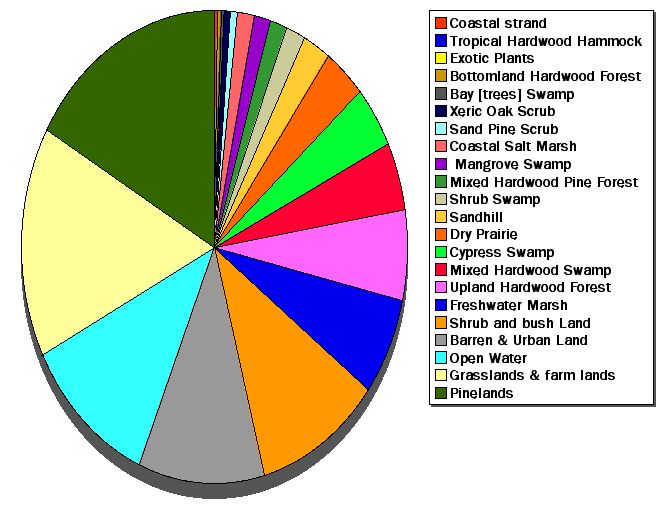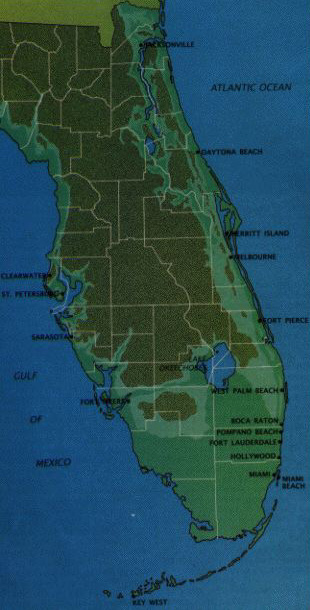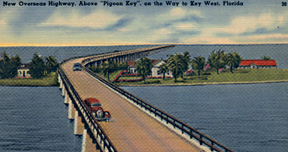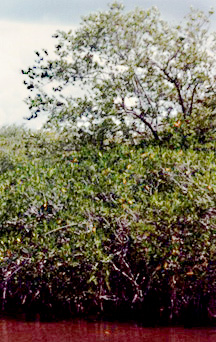 Florida's natural areas
Florida's natural areasNavigating the site:
Miami River: "a beautiful clear-water stream,
its banks lined with towering coco-palms & mangroves."
Ralph Middleton Munroe, c. 1900
"The
stability of nature on the
planet -- that old and simple
promise to the living, which is
written in every sedimentary rock
-- is threatened by nature's own
product, man."
Loren
Eisley, 1960
![]()
Florida is at once a place in the American literary imagination and a projection of European ideas upon the landscape. Named for the spring celebration of Christian Spain to salute the flowering of dogwoods, yellow jessamine and magnolia, “La Florida” was as much a Spanish wish as it was an adequate ecological description of the conditions within which Europeans found themselves. The impact of the Reconquista on Florida was less to be sure than the changes wrought in Hispaniola, Mexico, and Peru.
After discovery, Florida early became the borderland where English culture sullied itself in the tropic waters of Creole, Spanish, French, Dutch, and Irish customs. The border between the tropical salt-water forest to fresh water, bottom-land hardwood swamp is perceptibly revealed in the Mangrove coasts of the south and the Cypress forests of the central peninsula.
 Florida
is an isle of many different forests growing
on a peninsula of marine deposits, sand, corals, crushed shells, and fish-bones. The earliest
natives were killed or driven off by Spanish diseases, becoming the raw
landscape devoid of large human populations. Into this empty vessel Seminole
culture poured south from Georgia. These peoples found and exploited a
niche and flourished in the absence of the original Timucua and Ais peoples.
They retreated to impenetrable fresh water swamps and mangrove forests.
These Seminole families fished and hunted in the gulf and south coasts
numberless bayous, rivers, and swamps.
Florida
is an isle of many different forests growing
on a peninsula of marine deposits, sand, corals, crushed shells, and fish-bones. The earliest
natives were killed or driven off by Spanish diseases, becoming the raw
landscape devoid of large human populations. Into this empty vessel Seminole
culture poured south from Georgia. These peoples found and exploited a
niche and flourished in the absence of the original Timucua and Ais peoples.
They retreated to impenetrable fresh water swamps and mangrove forests.
These Seminole families fished and hunted in the gulf and south coasts
numberless bayous, rivers, and swamps.
Geology | Reef track | Bryozoans | Utility of Limestone | Sea level | types of vegetation | return to top
The sea and the fresh marsh commingle so intimately in Florida that the lime alone remains of relict animals that once lived in these watery isles. Newly emerged from the Pleistocen seas the coastal sand dunes are the encroaching edge of the encircling sea.
Among its many famous
visitors, John Muir wrote, “I am now in the hot gardens of the sun, where the palm meets the pines, longed and prayed for and often visited
in dreams, and though lonely tonight amid this multitude of strangers,
strange plants, strange winds blowing gently, whispering, cooing in a
language I never learned, and strange birds also, everything solid or
spiritual full of influences I never felt, yet I thank the lord with all
my heart for his goodness in granting me admission to this magnificent
realm." Besides Harriet Beecher Stowe, and William Jennings Bryan,
the state has attracted 8 million people since world war two ended!
sun, where the palm meets the pines, longed and prayed for and often visited
in dreams, and though lonely tonight amid this multitude of strangers,
strange plants, strange winds blowing gently, whispering, cooing in a
language I never learned, and strange birds also, everything solid or
spiritual full of influences I never felt, yet I thank the lord with all
my heart for his goodness in granting me admission to this magnificent
realm." Besides Harriet Beecher Stowe, and William Jennings Bryan,
the state has attracted 8 million people since world war two ended!
The confines of this long projecting finger of flat lands into the sea is what Zora Neal Hurston described as a land “sired by the sun from the sea.” It is dominated by what Marjorie Stoneman Douglas referred to as a forest comprised of an “infinity of pines.” The wetlands, forests, and shores of the state reach deep into the tropics from the deep south. Somewhere between the great central ridge province and the coastal plain the oak, hickory, maple forests are replaced by tropical hardwood hammock. Any where along this southward journey of the land into the sea a few inches of relief may spell the difference between swamp and desert or between water logged submerged and conditions.
"the level of the sea has fluctuated . . . . at times Florida disappeared entirely." (20)
Hoffmeister, John Edward, LAND FROM THE SEA: THE GEOLOGIC STORY OF SOUTH FLORIDA. Coral Gables: University of Miami Press, 1974.

"What we see as the state of Florida is only the upper part of a much more substantial barrier. If the sea level were lowered about 50 fathoms (300 feet), the width of the finger would be greatly enlarged and it could be seen that Florida rests on a broad, platform -- the Floridan Plateau. (19)
When the land is high, erosion is active and new landforms, such as river valleys, are made. When the sea extends over the land, new rock deposits, cheifly limestone in Florida, are formed in the shallow sea bottom, largely from the accumulation of shells and other skeletal materials of the organisms that lived in the sea. (21)
"Next to Alaska it [Florida] has the longest coastline (1,350 miles)
...."
"It has a flourishing living coral reef tract and a unique chain of islands, the Florida Keys, which are made cheifly of an ancient coral reef." {called KEY LARGO LIMESTONE
"This southern coral-bearing area of living and fossil coral with its associated plants and animals might be called the coral reef zone of Florida." (21)
"The rock formations of southern Florida are among
the youngest in the country." (21)
Tamiami Limestone formed about 6 million years ago. (22)
STRATIGRAPHY: (23-24)
27) topographically uncomplicated . . . "it is surprising to see what a difference is made by only a few feet in elevation."
The Atlantic Coastal ridge "on it are located the main cities of
eastern Florida . . ..The highest point . . . is about 20 feet above sea
level in Coconut Grove. . . ."
"The low broad expanse of the Evergaldes is about ten feet above
sea level in southern Broward County." {3' in . Dade}
28) "The Atlantic coastal ridge has been called the
rim of the Everglades."
29-33) bedrock of Miami is oolitic limestone, cross bedded, rock {Silver Bluff, Bayshore drive in the Coconut Grove district south of the Miami River.}
Mangrove shoals of Florida Bay, along the Everglades shore.
Utility of limestone
32) "By far the greater part of oolite that is quarried is then crushed and converted into concrete building blocks or used in making roads, ready-mixed concrete, and cement."
(33) "The mining of oolite is big business . . . . relative ease of extraction.. . . Oolite is a relatively soft rock easy to crush."
"Large quantities of Florida oolite are now being shipped to more distant places."
34) "Oolite, like coral, is very porous. Rainwater seeps quickly beneath the surface and builds up the groundwater supply whre it is stored for our everyday use."
Geology | Reef track | Bryozoans | Utility of Limestone | Sea level | types of vegetation | return to top
Bryozoans
35) ". . . the Everglades rocks . . .contain large numbers of massive colonies of what are known as bryozoans."
35) "A bryozoan (which means 'moss animal') is a
minute, invertebrate, marine animal, usually less than one millimeter
in length, which seceretes a small calcareous cell in which to live. Bryozoans
grow together to form calcareous colonies, many of which become a foot
or more in diameter and develop a typically knobby structure.
"Those that are found in the Everglades apparently encrusted various
typres of sea grass that grwe on the ocean floor."
37) "Bryozoans are by far the dominant constituent of everglades rock." "70% by volume"
"They ay belong to a single species, SCHIZOPORELLA FLORIDANA." (40) covers an area of at least 2,000 sq. miles one of the largest in US.
Geology | Reef track | Bryozoans | Utility of Limestone | Sea level | types of vegetation | return to top
Florida Reef Track
70) "The Florida reef tract is an arc-shaped shallow water limestone shelf that is bounded on the seaward side by the deep waters of the Florida straits and shoreward by the Florida Keys. It has a length of about 150 miles and an average width of four miles. The surface is irregular and varies in depth from 0 to 50 feet
73) "Corals are the most attractive and appealing features of the . . . tract. Coral colonies vary greatly in size and shape.
75) "The corals of the outer reef live in the most active environment . . ..
76) The greatest variety of corals can be found living here. A few . . . dominate and provide the main structure of the reef." Acropora palmata; Acropora cervicornis, Montastrea annularis, Diploria (brain corals).
The reefs create the that land that sustains the keys.
79) "How fast corals grow depends on their species
and the environment in which they live.
"The average upward growth rate of . . . star coral Montastrea
annularis amounted to 10.7 millimeters (80) At this growth rate . . .
of one foot would take 28,5 years."
Acropora cervicornis grows at 100 mm or 4 inches/ annually
83) "islands made of old coral reefs for a distance
of over 100 miles into the open ocean."
The highest point is Windley Key, which reaches an elevation of 18 feet.
". . . it is estimated that mangrove swamps occupy at least half
of the total area of the Keys, thus giving the impression that the land
is much larger in area than it really is.
Geology | Reef track | Bryozoans | Utility of Limestone | Sea level | types of vegetation | return to top
Geologically, the keys have emerged slowly over time.
92) "the lower keys were formed of oolitic Miami limestone, the origin of the upper keys -- the real coral reef keys -- is quite different. They are made of key Largo Limestone, which also extends beneath the Miami limestone of the lower keys.
94) "At that time the sea level was about twenty-five feet higher than at present. This took place about 100,000 years ago during the Sangamon interglacial period."
95) ESSENTIAL CORING: "This was done at Looe Key, {reef} opposite Big Pine Key. Here, at a depth of (96) about 60 feet, speciments of elkhorn coral, Acropora palmata, were found. "It demonstrates the existence of an outer reef at the time the keys were being made as patch reefs in the back reef area."
Hoffmeister, John Edward, LAND FROM THE SEA: THE GEOLOGIC STORY OF SOUTH FLORIDA. Coral Gables: University of Miami Press, 1974.
This button below works as a navigational aid.
schedule | Research home | Atlas | site-map | Ecology | laws | reliable web sites | quick look
Science Index | Site Analysis | Population Index | Global Warming Index | Nature Index | Research sites | Genes
Terms | Glossary | Word webs | Basic vocabulary | Advanced Vocabulary | Antonyms | Synonyms | Etymology | Concepts
Writing | Interviews | Free Writing
Geology | Reef track | Bryozoans | Utility of Limestone | Sea level | types of vegetation | return to top

